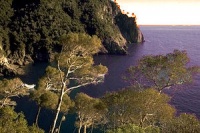More actions
mNo edit summary |
mNo edit summary |
||
| Line 7: | Line 7: | ||
While the temperatures still regularly top 36ºC (roughly 100ºF or 310ºK), the climate of T'Ralor is mild by [[Vulcan (Planet)|Vulcan]] standards. In higher regions [[Ic'tan|ic'tan]] conifers have settled, likely the result of centuries-ago traders bringing seedlings from [[Llangon Mountains|Llangon]]. | While the temperatures still regularly top 36ºC (roughly 100ºF or 310ºK), the climate of T'Ralor is mild by [[Vulcan (Planet)|Vulcan]] standards. In higher regions [[Ic'tan|ic'tan]] conifers have settled, likely the result of centuries-ago traders bringing seedlings from [[Llangon Mountains|Llangon]]. | ||
T'Ralor also holds the largest population of wild [[Sehlat|sehlat]] and an abundance of other wildlife with many indigenous subspecies such as the | T'Ralor also holds the largest population of wild [[Sehlat|sehlat]] and an abundance of other wildlife with many indigenous subspecies such as the '''teresh-ka''', a close relative of the [[Shiranah|shiranah]] found on the [[Na'Nam]] continent. | ||
[[Category: Vulcan (Planet)]] | [[Category: Vulcan (Planet)]] | ||
Latest revision as of 22:45, 18 November 2015
The T'Ralor Nature Preserve is located in the southern part of the continent of Han-Shir, along the west coast of the Voroth Sea.

Famous for being the largest wilderness area and one of the few temperate zones on the planet, T'Ralor not only boasts of actual rivers and lakes in addition to underground streams, but heavily forested areas including shaforr, palm and nut trees. Several types of the famous Vulcan favinit orchids can be found growing wild, as well as mulitple rare variations of the y'ranth, commonly referred to as Eridani lavender.
While the temperatures still regularly top 36ºC (roughly 100ºF or 310ºK), the climate of T'Ralor is mild by Vulcan standards. In higher regions ic'tan conifers have settled, likely the result of centuries-ago traders bringing seedlings from Llangon.
T'Ralor also holds the largest population of wild sehlat and an abundance of other wildlife with many indigenous subspecies such as the teresh-ka, a close relative of the shiranah found on the Na'Nam continent.
